BUS6001 Contemporary Management Issues: Sainsbury's & Argos Report
VerifiedAdded on 2023/06/17
|17
|5285
|313
Report
AI Summary
This report analyzes the contemporary management issues faced by Sainsbury's following its acquisition of Argos, examining the types of changes implemented (developmental, transformational, and transitional) and applying Kotter's 8-step change model to understand the change management process. It explores the company's corporate social responsibility (CSR) initiatives using the Triple Bottom Line approach, focusing on profit, people, and planet, and conducts a PESTLE analysis to identify key political, economic, social, technological, legal, and environmental factors affecting the business. The report also discusses the strategic decisions made by Sainsbury's, organizational change, and the application of Porter’s Five Forces to assess the competitive landscape. Furthermore, it considers ethical business concerns, the impact of social, demographic, and globalization changes, and stakeholder mapping, concluding with recommendations for enhancing Sainsbury's response to dynamic forces of change. This complete assignment is available on Desklib, a platform providing study tools for students.
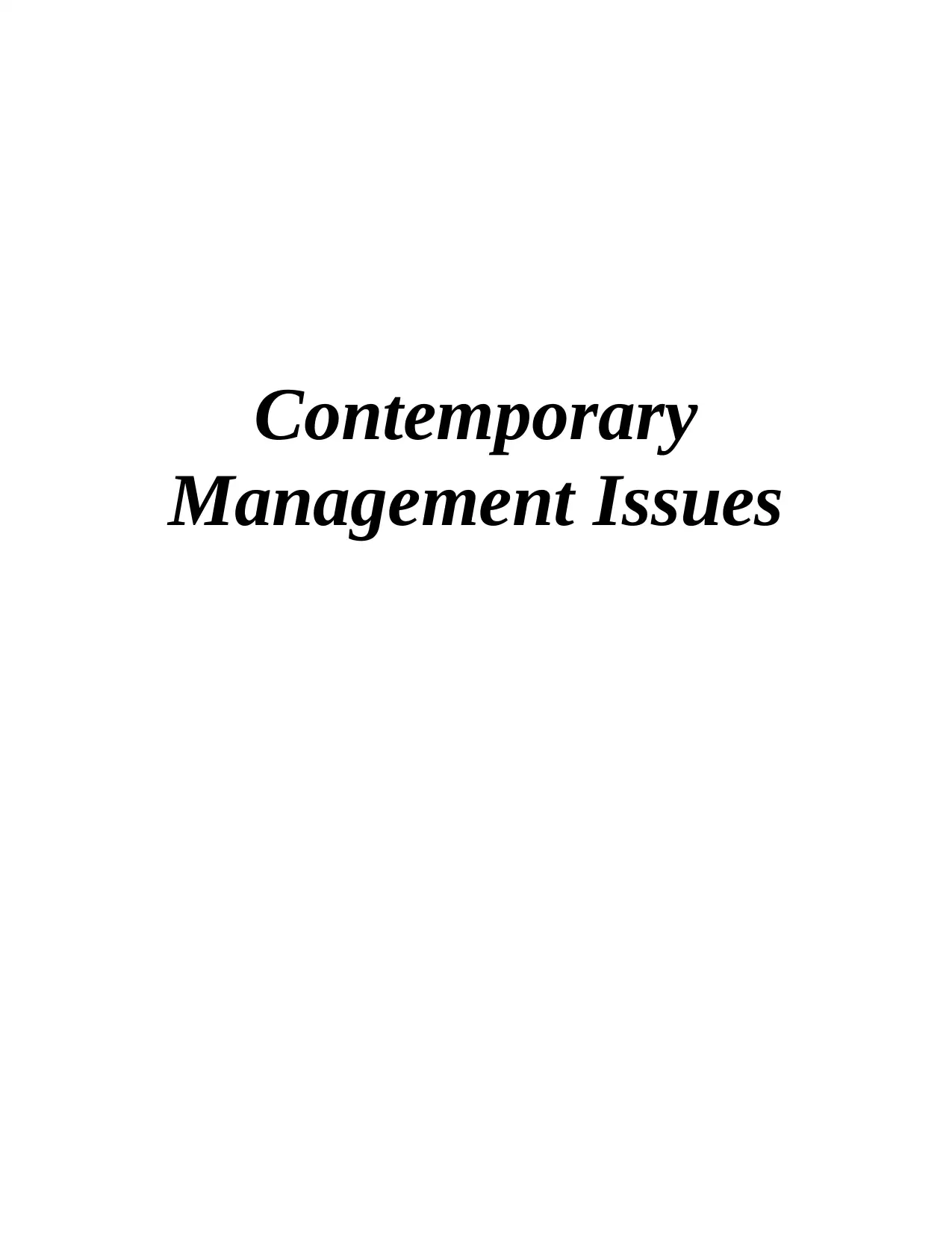
Contemporary
Management Issues
Management Issues
Paraphrase This Document
Need a fresh take? Get an instant paraphrase of this document with our AI Paraphraser
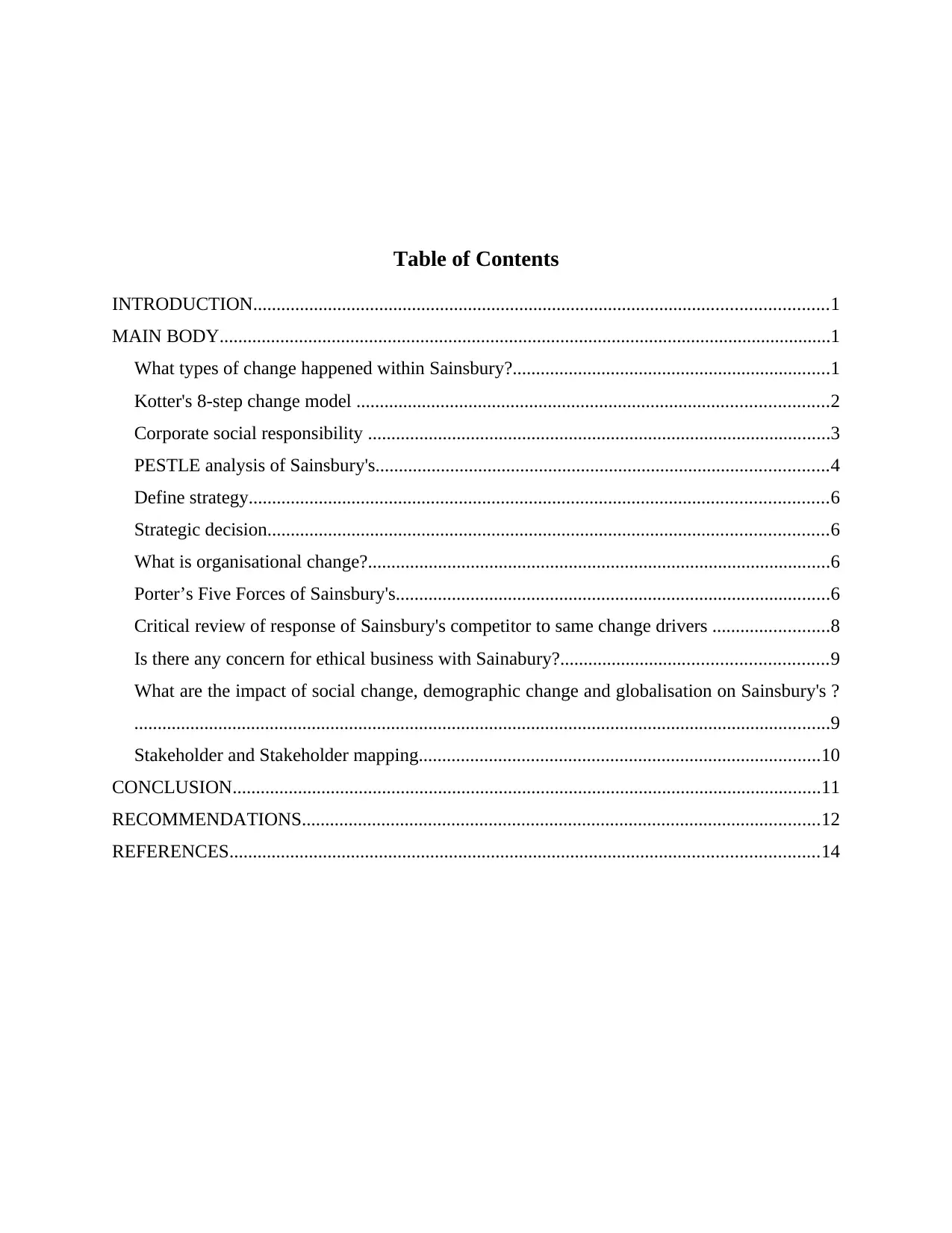
Table of Contents
INTRODUCTION...........................................................................................................................1
MAIN BODY...................................................................................................................................1
What types of change happened within Sainsbury?....................................................................1
Kotter's 8-step change model .....................................................................................................2
Corporate social responsibility ...................................................................................................3
PESTLE analysis of Sainsbury's.................................................................................................4
Define strategy............................................................................................................................6
Strategic decision........................................................................................................................6
What is organisational change?...................................................................................................6
Porter’s Five Forces of Sainsbury's.............................................................................................6
Critical review of response of Sainsbury's competitor to same change drivers .........................8
Is there any concern for ethical business with Sainabury?.........................................................9
What are the impact of social change, demographic change and globalisation on Sainsbury's ?
.....................................................................................................................................................9
Stakeholder and Stakeholder mapping......................................................................................10
CONCLUSION..............................................................................................................................11
RECOMMENDATIONS...............................................................................................................12
REFERENCES..............................................................................................................................14
INTRODUCTION...........................................................................................................................1
MAIN BODY...................................................................................................................................1
What types of change happened within Sainsbury?....................................................................1
Kotter's 8-step change model .....................................................................................................2
Corporate social responsibility ...................................................................................................3
PESTLE analysis of Sainsbury's.................................................................................................4
Define strategy............................................................................................................................6
Strategic decision........................................................................................................................6
What is organisational change?...................................................................................................6
Porter’s Five Forces of Sainsbury's.............................................................................................6
Critical review of response of Sainsbury's competitor to same change drivers .........................8
Is there any concern for ethical business with Sainabury?.........................................................9
What are the impact of social change, demographic change and globalisation on Sainsbury's ?
.....................................................................................................................................................9
Stakeholder and Stakeholder mapping......................................................................................10
CONCLUSION..............................................................................................................................11
RECOMMENDATIONS...............................................................................................................12
REFERENCES..............................................................................................................................14
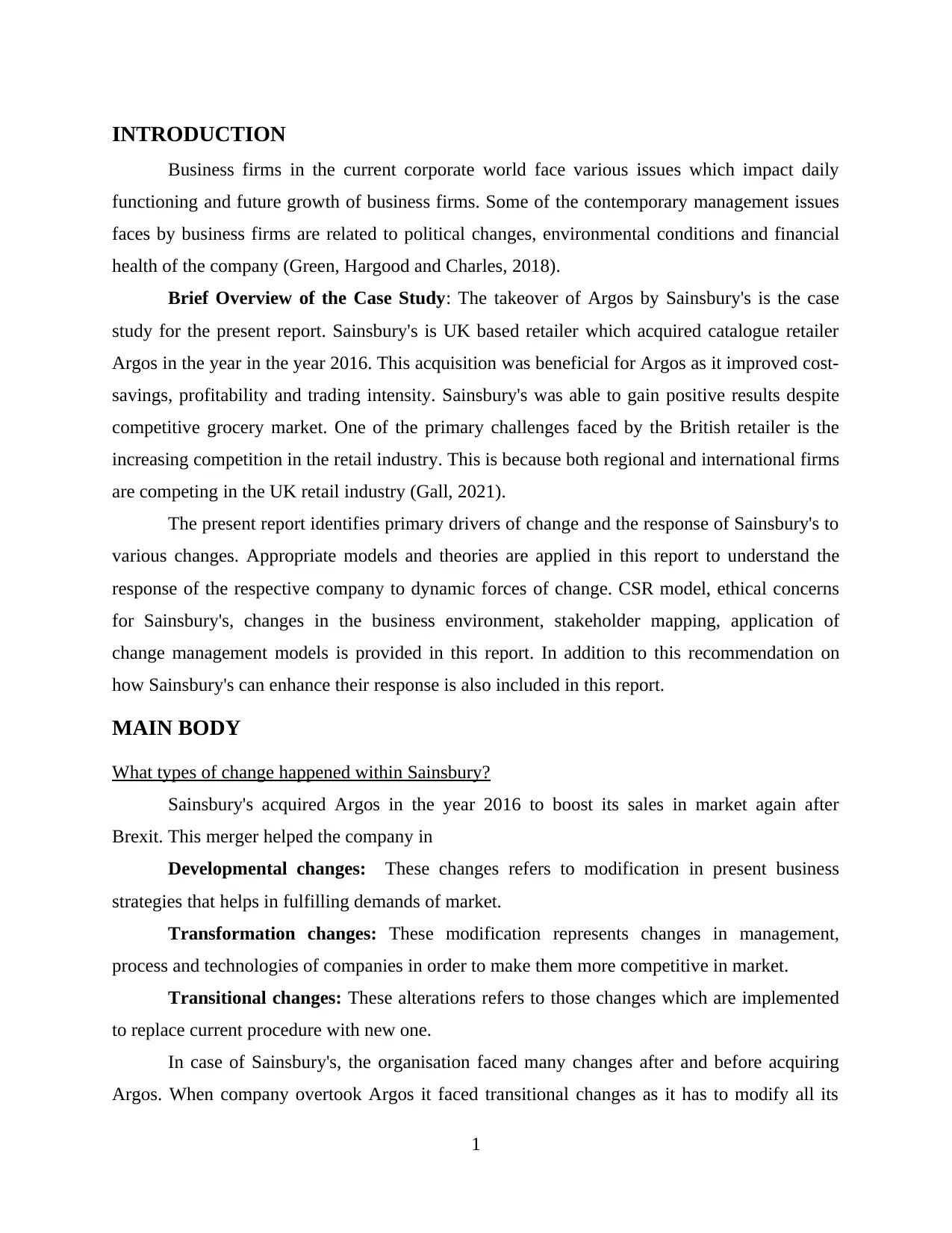
INTRODUCTION
Business firms in the current corporate world face various issues which impact daily
functioning and future growth of business firms. Some of the contemporary management issues
faces by business firms are related to political changes, environmental conditions and financial
health of the company (Green, Hargood and Charles, 2018).
Brief Overview of the Case Study: The takeover of Argos by Sainsbury's is the case
study for the present report. Sainsbury's is UK based retailer which acquired catalogue retailer
Argos in the year in the year 2016. This acquisition was beneficial for Argos as it improved cost-
savings, profitability and trading intensity. Sainsbury's was able to gain positive results despite
competitive grocery market. One of the primary challenges faced by the British retailer is the
increasing competition in the retail industry. This is because both regional and international firms
are competing in the UK retail industry (Gall, 2021).
The present report identifies primary drivers of change and the response of Sainsbury's to
various changes. Appropriate models and theories are applied in this report to understand the
response of the respective company to dynamic forces of change. CSR model, ethical concerns
for Sainsbury's, changes in the business environment, stakeholder mapping, application of
change management models is provided in this report. In addition to this recommendation on
how Sainsbury's can enhance their response is also included in this report.
MAIN BODY
What types of change happened within Sainsbury?
Sainsbury's acquired Argos in the year 2016 to boost its sales in market again after
Brexit. This merger helped the company in
Developmental changes: These changes refers to modification in present business
strategies that helps in fulfilling demands of market.
Transformation changes: These modification represents changes in management,
process and technologies of companies in order to make them more competitive in market.
Transitional changes: These alterations refers to those changes which are implemented
to replace current procedure with new one.
In case of Sainsbury's, the organisation faced many changes after and before acquiring
Argos. When company overtook Argos it faced transitional changes as it has to modify all its
1
Business firms in the current corporate world face various issues which impact daily
functioning and future growth of business firms. Some of the contemporary management issues
faces by business firms are related to political changes, environmental conditions and financial
health of the company (Green, Hargood and Charles, 2018).
Brief Overview of the Case Study: The takeover of Argos by Sainsbury's is the case
study for the present report. Sainsbury's is UK based retailer which acquired catalogue retailer
Argos in the year in the year 2016. This acquisition was beneficial for Argos as it improved cost-
savings, profitability and trading intensity. Sainsbury's was able to gain positive results despite
competitive grocery market. One of the primary challenges faced by the British retailer is the
increasing competition in the retail industry. This is because both regional and international firms
are competing in the UK retail industry (Gall, 2021).
The present report identifies primary drivers of change and the response of Sainsbury's to
various changes. Appropriate models and theories are applied in this report to understand the
response of the respective company to dynamic forces of change. CSR model, ethical concerns
for Sainsbury's, changes in the business environment, stakeholder mapping, application of
change management models is provided in this report. In addition to this recommendation on
how Sainsbury's can enhance their response is also included in this report.
MAIN BODY
What types of change happened within Sainsbury?
Sainsbury's acquired Argos in the year 2016 to boost its sales in market again after
Brexit. This merger helped the company in
Developmental changes: These changes refers to modification in present business
strategies that helps in fulfilling demands of market.
Transformation changes: These modification represents changes in management,
process and technologies of companies in order to make them more competitive in market.
Transitional changes: These alterations refers to those changes which are implemented
to replace current procedure with new one.
In case of Sainsbury's, the organisation faced many changes after and before acquiring
Argos. When company overtook Argos it faced transitional changes as it has to modify all its
1
⊘ This is a preview!⊘
Do you want full access?
Subscribe today to unlock all pages.

Trusted by 1+ million students worldwide
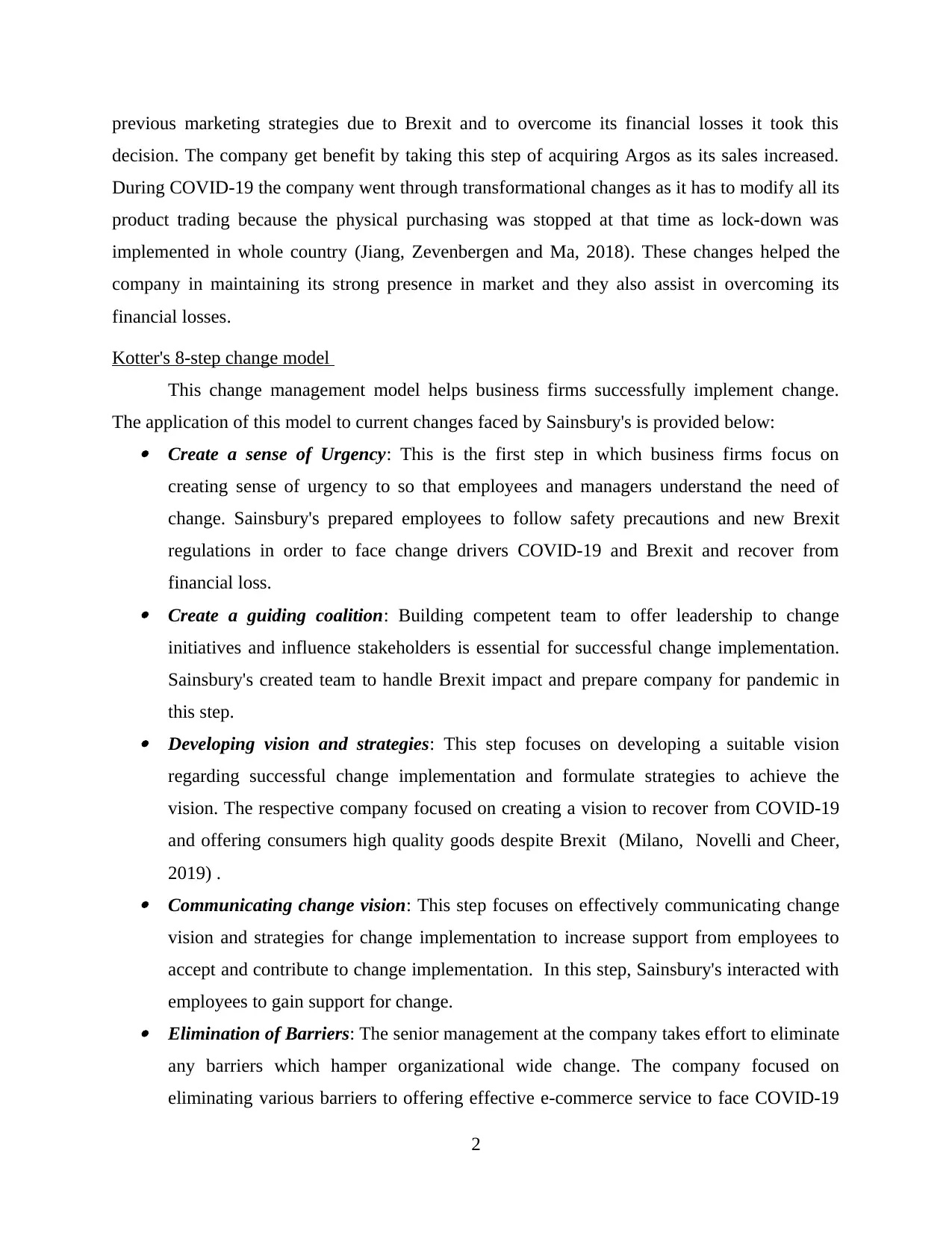
previous marketing strategies due to Brexit and to overcome its financial losses it took this
decision. The company get benefit by taking this step of acquiring Argos as its sales increased.
During COVID-19 the company went through transformational changes as it has to modify all its
product trading because the physical purchasing was stopped at that time as lock-down was
implemented in whole country (Jiang, Zevenbergen and Ma, 2018). These changes helped the
company in maintaining its strong presence in market and they also assist in overcoming its
financial losses.
Kotter's 8-step change model
This change management model helps business firms successfully implement change.
The application of this model to current changes faced by Sainsbury's is provided below: Create a sense of Urgency: This is the first step in which business firms focus on
creating sense of urgency to so that employees and managers understand the need of
change. Sainsbury's prepared employees to follow safety precautions and new Brexit
regulations in order to face change drivers COVID-19 and Brexit and recover from
financial loss. Create a guiding coalition: Building competent team to offer leadership to change
initiatives and influence stakeholders is essential for successful change implementation.
Sainsbury's created team to handle Brexit impact and prepare company for pandemic in
this step. Developing vision and strategies: This step focuses on developing a suitable vision
regarding successful change implementation and formulate strategies to achieve the
vision. The respective company focused on creating a vision to recover from COVID-19
and offering consumers high quality goods despite Brexit (Milano, Novelli and Cheer,
2019) . Communicating change vision: This step focuses on effectively communicating change
vision and strategies for change implementation to increase support from employees to
accept and contribute to change implementation. In this step, Sainsbury's interacted with
employees to gain support for change. Elimination of Barriers: The senior management at the company takes effort to eliminate
any barriers which hamper organizational wide change. The company focused on
eliminating various barriers to offering effective e-commerce service to face COVID-19
2
decision. The company get benefit by taking this step of acquiring Argos as its sales increased.
During COVID-19 the company went through transformational changes as it has to modify all its
product trading because the physical purchasing was stopped at that time as lock-down was
implemented in whole country (Jiang, Zevenbergen and Ma, 2018). These changes helped the
company in maintaining its strong presence in market and they also assist in overcoming its
financial losses.
Kotter's 8-step change model
This change management model helps business firms successfully implement change.
The application of this model to current changes faced by Sainsbury's is provided below: Create a sense of Urgency: This is the first step in which business firms focus on
creating sense of urgency to so that employees and managers understand the need of
change. Sainsbury's prepared employees to follow safety precautions and new Brexit
regulations in order to face change drivers COVID-19 and Brexit and recover from
financial loss. Create a guiding coalition: Building competent team to offer leadership to change
initiatives and influence stakeholders is essential for successful change implementation.
Sainsbury's created team to handle Brexit impact and prepare company for pandemic in
this step. Developing vision and strategies: This step focuses on developing a suitable vision
regarding successful change implementation and formulate strategies to achieve the
vision. The respective company focused on creating a vision to recover from COVID-19
and offering consumers high quality goods despite Brexit (Milano, Novelli and Cheer,
2019) . Communicating change vision: This step focuses on effectively communicating change
vision and strategies for change implementation to increase support from employees to
accept and contribute to change implementation. In this step, Sainsbury's interacted with
employees to gain support for change. Elimination of Barriers: The senior management at the company takes effort to eliminate
any barriers which hamper organizational wide change. The company focused on
eliminating various barriers to offering effective e-commerce service to face COVID-19
2
Paraphrase This Document
Need a fresh take? Get an instant paraphrase of this document with our AI Paraphraser
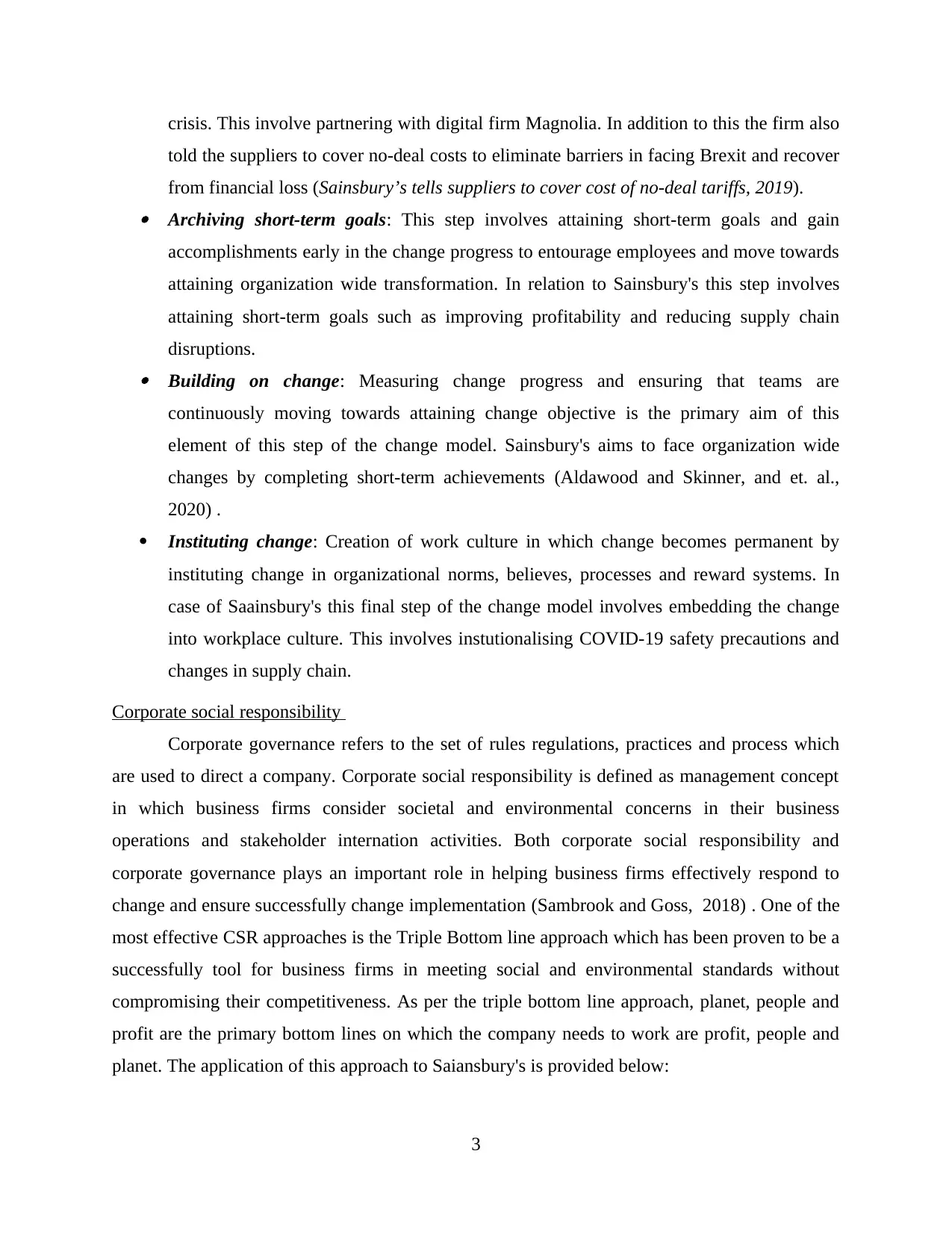
crisis. This involve partnering with digital firm Magnolia. In addition to this the firm also
told the suppliers to cover no-deal costs to eliminate barriers in facing Brexit and recover
from financial loss (Sainsbury’s tells suppliers to cover cost of no-deal tariffs, 2019). Archiving short-term goals: This step involves attaining short-term goals and gain
accomplishments early in the change progress to entourage employees and move towards
attaining organization wide transformation. In relation to Sainsbury's this step involves
attaining short-term goals such as improving profitability and reducing supply chain
disruptions. Building on change: Measuring change progress and ensuring that teams are
continuously moving towards attaining change objective is the primary aim of this
element of this step of the change model. Sainsbury's aims to face organization wide
changes by completing short-term achievements (Aldawood and Skinner, and et. al.,
2020) .
Instituting change: Creation of work culture in which change becomes permanent by
instituting change in organizational norms, believes, processes and reward systems. In
case of Saainsbury's this final step of the change model involves embedding the change
into workplace culture. This involves instutionalising COVID-19 safety precautions and
changes in supply chain.
Corporate social responsibility
Corporate governance refers to the set of rules regulations, practices and process which
are used to direct a company. Corporate social responsibility is defined as management concept
in which business firms consider societal and environmental concerns in their business
operations and stakeholder internation activities. Both corporate social responsibility and
corporate governance plays an important role in helping business firms effectively respond to
change and ensure successfully change implementation (Sambrook and Goss, 2018) . One of the
most effective CSR approaches is the Triple Bottom line approach which has been proven to be a
successfully tool for business firms in meeting social and environmental standards without
compromising their competitiveness. As per the triple bottom line approach, planet, people and
profit are the primary bottom lines on which the company needs to work are profit, people and
planet. The application of this approach to Saiansbury's is provided below:
3
told the suppliers to cover no-deal costs to eliminate barriers in facing Brexit and recover
from financial loss (Sainsbury’s tells suppliers to cover cost of no-deal tariffs, 2019). Archiving short-term goals: This step involves attaining short-term goals and gain
accomplishments early in the change progress to entourage employees and move towards
attaining organization wide transformation. In relation to Sainsbury's this step involves
attaining short-term goals such as improving profitability and reducing supply chain
disruptions. Building on change: Measuring change progress and ensuring that teams are
continuously moving towards attaining change objective is the primary aim of this
element of this step of the change model. Sainsbury's aims to face organization wide
changes by completing short-term achievements (Aldawood and Skinner, and et. al.,
2020) .
Instituting change: Creation of work culture in which change becomes permanent by
instituting change in organizational norms, believes, processes and reward systems. In
case of Saainsbury's this final step of the change model involves embedding the change
into workplace culture. This involves instutionalising COVID-19 safety precautions and
changes in supply chain.
Corporate social responsibility
Corporate governance refers to the set of rules regulations, practices and process which
are used to direct a company. Corporate social responsibility is defined as management concept
in which business firms consider societal and environmental concerns in their business
operations and stakeholder internation activities. Both corporate social responsibility and
corporate governance plays an important role in helping business firms effectively respond to
change and ensure successfully change implementation (Sambrook and Goss, 2018) . One of the
most effective CSR approaches is the Triple Bottom line approach which has been proven to be a
successfully tool for business firms in meeting social and environmental standards without
compromising their competitiveness. As per the triple bottom line approach, planet, people and
profit are the primary bottom lines on which the company needs to work are profit, people and
planet. The application of this approach to Saiansbury's is provided below:
3
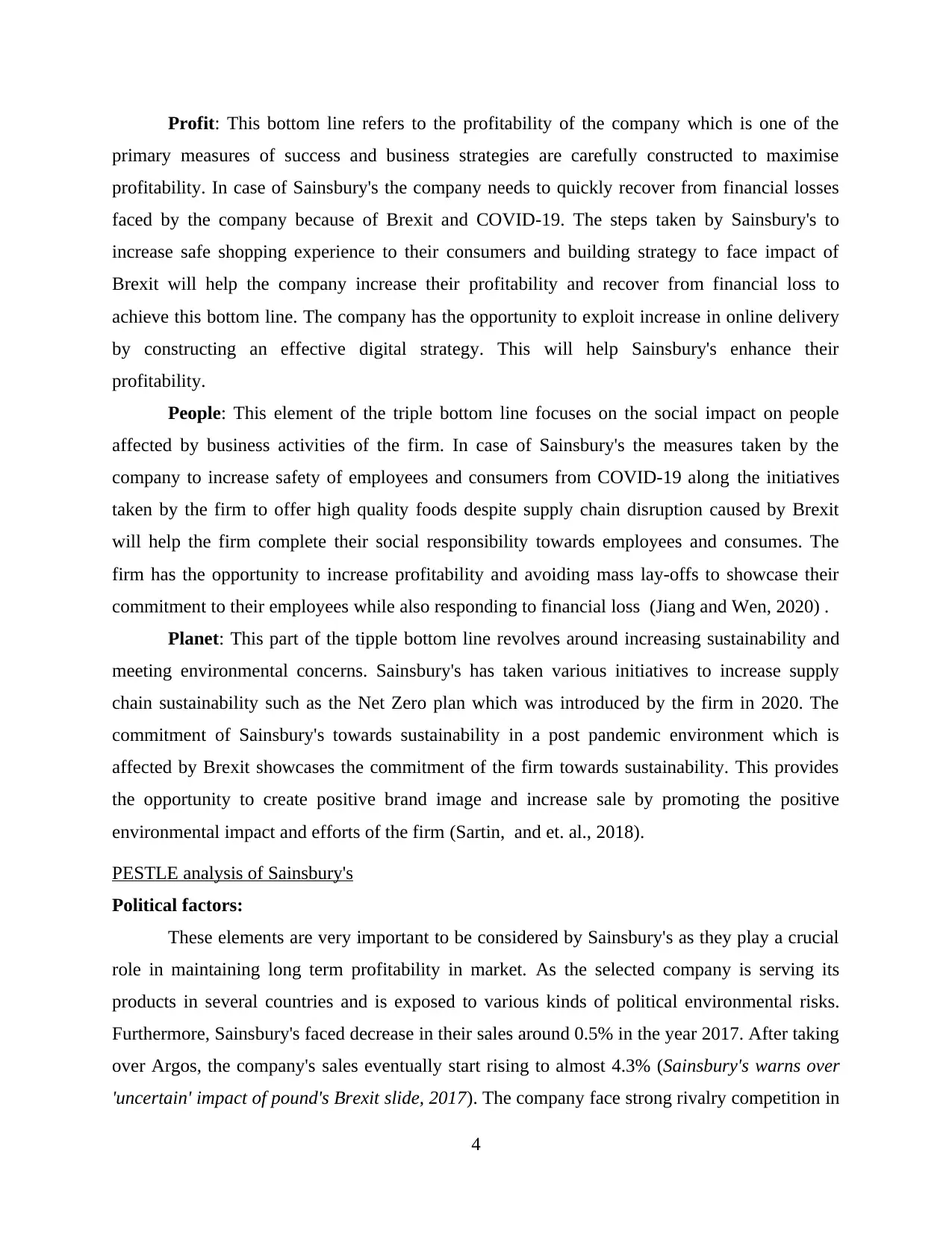
Profit: This bottom line refers to the profitability of the company which is one of the
primary measures of success and business strategies are carefully constructed to maximise
profitability. In case of Sainsbury's the company needs to quickly recover from financial losses
faced by the company because of Brexit and COVID-19. The steps taken by Sainsbury's to
increase safe shopping experience to their consumers and building strategy to face impact of
Brexit will help the company increase their profitability and recover from financial loss to
achieve this bottom line. The company has the opportunity to exploit increase in online delivery
by constructing an effective digital strategy. This will help Sainsbury's enhance their
profitability.
People: This element of the triple bottom line focuses on the social impact on people
affected by business activities of the firm. In case of Sainsbury's the measures taken by the
company to increase safety of employees and consumers from COVID-19 along the initiatives
taken by the firm to offer high quality foods despite supply chain disruption caused by Brexit
will help the firm complete their social responsibility towards employees and consumes. The
firm has the opportunity to increase profitability and avoiding mass lay-offs to showcase their
commitment to their employees while also responding to financial loss (Jiang and Wen, 2020) .
Planet: This part of the tipple bottom line revolves around increasing sustainability and
meeting environmental concerns. Sainsbury's has taken various initiatives to increase supply
chain sustainability such as the Net Zero plan which was introduced by the firm in 2020. The
commitment of Sainsbury's towards sustainability in a post pandemic environment which is
affected by Brexit showcases the commitment of the firm towards sustainability. This provides
the opportunity to create positive brand image and increase sale by promoting the positive
environmental impact and efforts of the firm (Sartin, and et. al., 2018).
PESTLE analysis of Sainsbury's
Political factors:
These elements are very important to be considered by Sainsbury's as they play a crucial
role in maintaining long term profitability in market. As the selected company is serving its
products in several countries and is exposed to various kinds of political environmental risks.
Furthermore, Sainsbury's faced decrease in their sales around 0.5% in the year 2017. After taking
over Argos, the company's sales eventually start rising to almost 4.3% (Sainsbury's warns over
'uncertain' impact of pound's Brexit slide, 2017). The company face strong rivalry competition in
4
primary measures of success and business strategies are carefully constructed to maximise
profitability. In case of Sainsbury's the company needs to quickly recover from financial losses
faced by the company because of Brexit and COVID-19. The steps taken by Sainsbury's to
increase safe shopping experience to their consumers and building strategy to face impact of
Brexit will help the company increase their profitability and recover from financial loss to
achieve this bottom line. The company has the opportunity to exploit increase in online delivery
by constructing an effective digital strategy. This will help Sainsbury's enhance their
profitability.
People: This element of the triple bottom line focuses on the social impact on people
affected by business activities of the firm. In case of Sainsbury's the measures taken by the
company to increase safety of employees and consumers from COVID-19 along the initiatives
taken by the firm to offer high quality foods despite supply chain disruption caused by Brexit
will help the firm complete their social responsibility towards employees and consumes. The
firm has the opportunity to increase profitability and avoiding mass lay-offs to showcase their
commitment to their employees while also responding to financial loss (Jiang and Wen, 2020) .
Planet: This part of the tipple bottom line revolves around increasing sustainability and
meeting environmental concerns. Sainsbury's has taken various initiatives to increase supply
chain sustainability such as the Net Zero plan which was introduced by the firm in 2020. The
commitment of Sainsbury's towards sustainability in a post pandemic environment which is
affected by Brexit showcases the commitment of the firm towards sustainability. This provides
the opportunity to create positive brand image and increase sale by promoting the positive
environmental impact and efforts of the firm (Sartin, and et. al., 2018).
PESTLE analysis of Sainsbury's
Political factors:
These elements are very important to be considered by Sainsbury's as they play a crucial
role in maintaining long term profitability in market. As the selected company is serving its
products in several countries and is exposed to various kinds of political environmental risks.
Furthermore, Sainsbury's faced decrease in their sales around 0.5% in the year 2017. After taking
over Argos, the company's sales eventually start rising to almost 4.3% (Sainsbury's warns over
'uncertain' impact of pound's Brexit slide, 2017). The company face strong rivalry competition in
4
⊘ This is a preview!⊘
Do you want full access?
Subscribe today to unlock all pages.

Trusted by 1+ million students worldwide
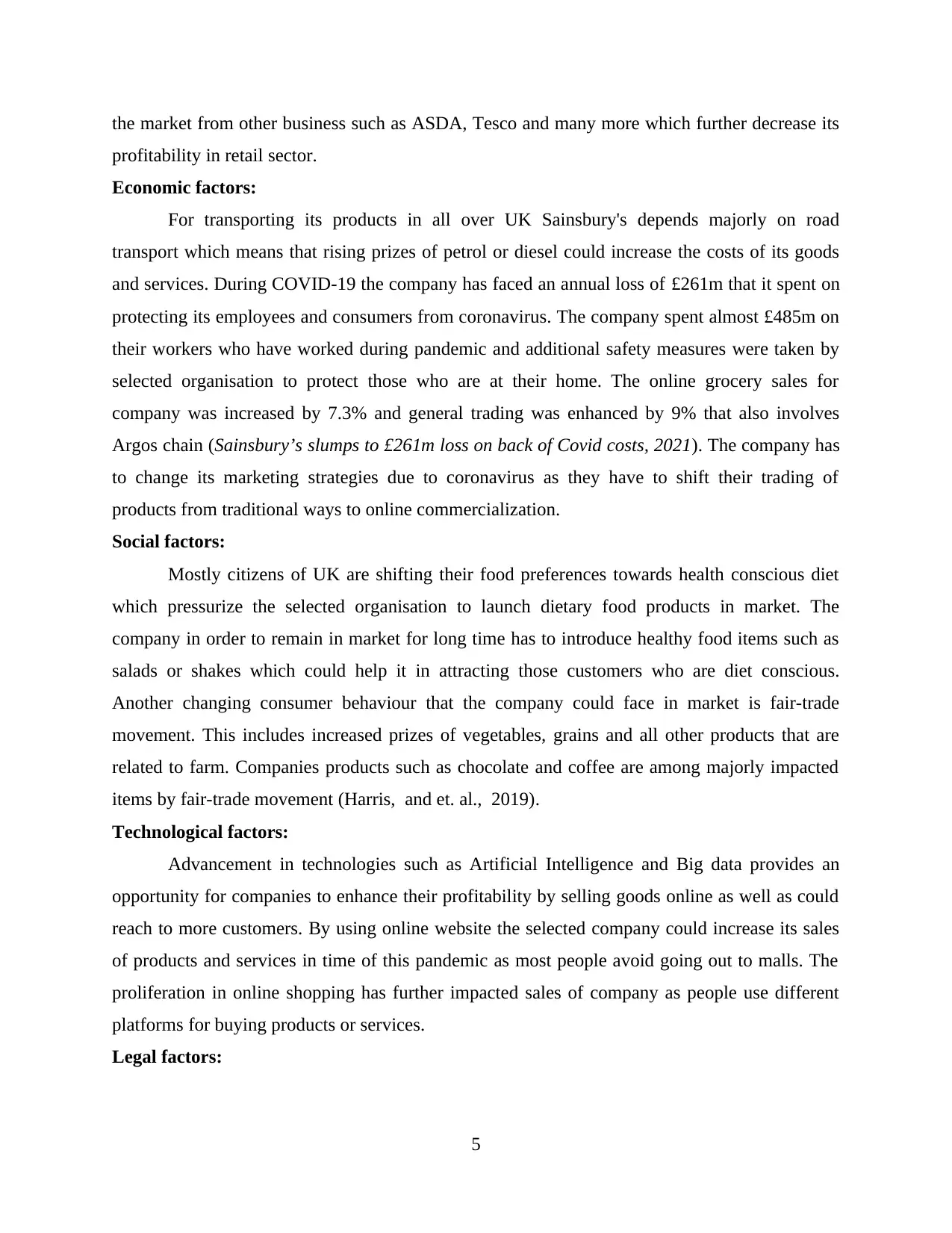
the market from other business such as ASDA, Tesco and many more which further decrease its
profitability in retail sector.
Economic factors:
For transporting its products in all over UK Sainsbury's depends majorly on road
transport which means that rising prizes of petrol or diesel could increase the costs of its goods
and services. During COVID-19 the company has faced an annual loss of £261m that it spent on
protecting its employees and consumers from coronavirus. The company spent almost £485m on
their workers who have worked during pandemic and additional safety measures were taken by
selected organisation to protect those who are at their home. The online grocery sales for
company was increased by 7.3% and general trading was enhanced by 9% that also involves
Argos chain (Sainsbury’s slumps to £261m loss on back of Covid costs, 2021). The company has
to change its marketing strategies due to coronavirus as they have to shift their trading of
products from traditional ways to online commercialization.
Social factors:
Mostly citizens of UK are shifting their food preferences towards health conscious diet
which pressurize the selected organisation to launch dietary food products in market. The
company in order to remain in market for long time has to introduce healthy food items such as
salads or shakes which could help it in attracting those customers who are diet conscious.
Another changing consumer behaviour that the company could face in market is fair-trade
movement. This includes increased prizes of vegetables, grains and all other products that are
related to farm. Companies products such as chocolate and coffee are among majorly impacted
items by fair-trade movement (Harris, and et. al., 2019).
Technological factors:
Advancement in technologies such as Artificial Intelligence and Big data provides an
opportunity for companies to enhance their profitability by selling goods online as well as could
reach to more customers. By using online website the selected company could increase its sales
of products and services in time of this pandemic as most people avoid going out to malls. The
proliferation in online shopping has further impacted sales of company as people use different
platforms for buying products or services.
Legal factors:
5
profitability in retail sector.
Economic factors:
For transporting its products in all over UK Sainsbury's depends majorly on road
transport which means that rising prizes of petrol or diesel could increase the costs of its goods
and services. During COVID-19 the company has faced an annual loss of £261m that it spent on
protecting its employees and consumers from coronavirus. The company spent almost £485m on
their workers who have worked during pandemic and additional safety measures were taken by
selected organisation to protect those who are at their home. The online grocery sales for
company was increased by 7.3% and general trading was enhanced by 9% that also involves
Argos chain (Sainsbury’s slumps to £261m loss on back of Covid costs, 2021). The company has
to change its marketing strategies due to coronavirus as they have to shift their trading of
products from traditional ways to online commercialization.
Social factors:
Mostly citizens of UK are shifting their food preferences towards health conscious diet
which pressurize the selected organisation to launch dietary food products in market. The
company in order to remain in market for long time has to introduce healthy food items such as
salads or shakes which could help it in attracting those customers who are diet conscious.
Another changing consumer behaviour that the company could face in market is fair-trade
movement. This includes increased prizes of vegetables, grains and all other products that are
related to farm. Companies products such as chocolate and coffee are among majorly impacted
items by fair-trade movement (Harris, and et. al., 2019).
Technological factors:
Advancement in technologies such as Artificial Intelligence and Big data provides an
opportunity for companies to enhance their profitability by selling goods online as well as could
reach to more customers. By using online website the selected company could increase its sales
of products and services in time of this pandemic as most people avoid going out to malls. The
proliferation in online shopping has further impacted sales of company as people use different
platforms for buying products or services.
Legal factors:
5
Paraphrase This Document
Need a fresh take? Get an instant paraphrase of this document with our AI Paraphraser
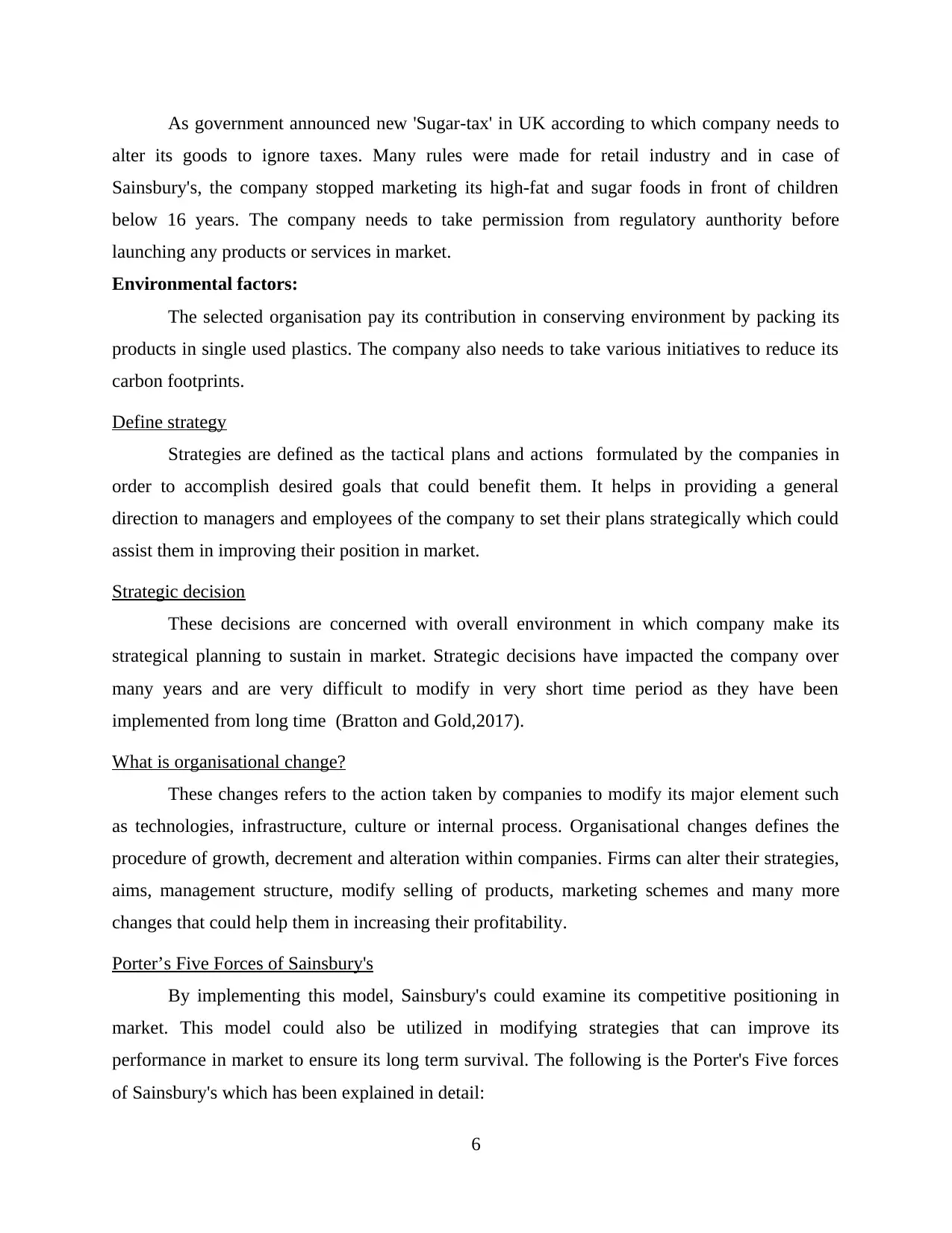
As government announced new 'Sugar-tax' in UK according to which company needs to
alter its goods to ignore taxes. Many rules were made for retail industry and in case of
Sainsbury's, the company stopped marketing its high-fat and sugar foods in front of children
below 16 years. The company needs to take permission from regulatory aunthority before
launching any products or services in market.
Environmental factors:
The selected organisation pay its contribution in conserving environment by packing its
products in single used plastics. The company also needs to take various initiatives to reduce its
carbon footprints.
Define strategy
Strategies are defined as the tactical plans and actions formulated by the companies in
order to accomplish desired goals that could benefit them. It helps in providing a general
direction to managers and employees of the company to set their plans strategically which could
assist them in improving their position in market.
Strategic decision
These decisions are concerned with overall environment in which company make its
strategical planning to sustain in market. Strategic decisions have impacted the company over
many years and are very difficult to modify in very short time period as they have been
implemented from long time (Bratton and Gold,2017).
What is organisational change?
These changes refers to the action taken by companies to modify its major element such
as technologies, infrastructure, culture or internal process. Organisational changes defines the
procedure of growth, decrement and alteration within companies. Firms can alter their strategies,
aims, management structure, modify selling of products, marketing schemes and many more
changes that could help them in increasing their profitability.
Porter’s Five Forces of Sainsbury's
By implementing this model, Sainsbury's could examine its competitive positioning in
market. This model could also be utilized in modifying strategies that can improve its
performance in market to ensure its long term survival. The following is the Porter's Five forces
of Sainsbury's which has been explained in detail:
6
alter its goods to ignore taxes. Many rules were made for retail industry and in case of
Sainsbury's, the company stopped marketing its high-fat and sugar foods in front of children
below 16 years. The company needs to take permission from regulatory aunthority before
launching any products or services in market.
Environmental factors:
The selected organisation pay its contribution in conserving environment by packing its
products in single used plastics. The company also needs to take various initiatives to reduce its
carbon footprints.
Define strategy
Strategies are defined as the tactical plans and actions formulated by the companies in
order to accomplish desired goals that could benefit them. It helps in providing a general
direction to managers and employees of the company to set their plans strategically which could
assist them in improving their position in market.
Strategic decision
These decisions are concerned with overall environment in which company make its
strategical planning to sustain in market. Strategic decisions have impacted the company over
many years and are very difficult to modify in very short time period as they have been
implemented from long time (Bratton and Gold,2017).
What is organisational change?
These changes refers to the action taken by companies to modify its major element such
as technologies, infrastructure, culture or internal process. Organisational changes defines the
procedure of growth, decrement and alteration within companies. Firms can alter their strategies,
aims, management structure, modify selling of products, marketing schemes and many more
changes that could help them in increasing their profitability.
Porter’s Five Forces of Sainsbury's
By implementing this model, Sainsbury's could examine its competitive positioning in
market. This model could also be utilized in modifying strategies that can improve its
performance in market to ensure its long term survival. The following is the Porter's Five forces
of Sainsbury's which has been explained in detail:
6
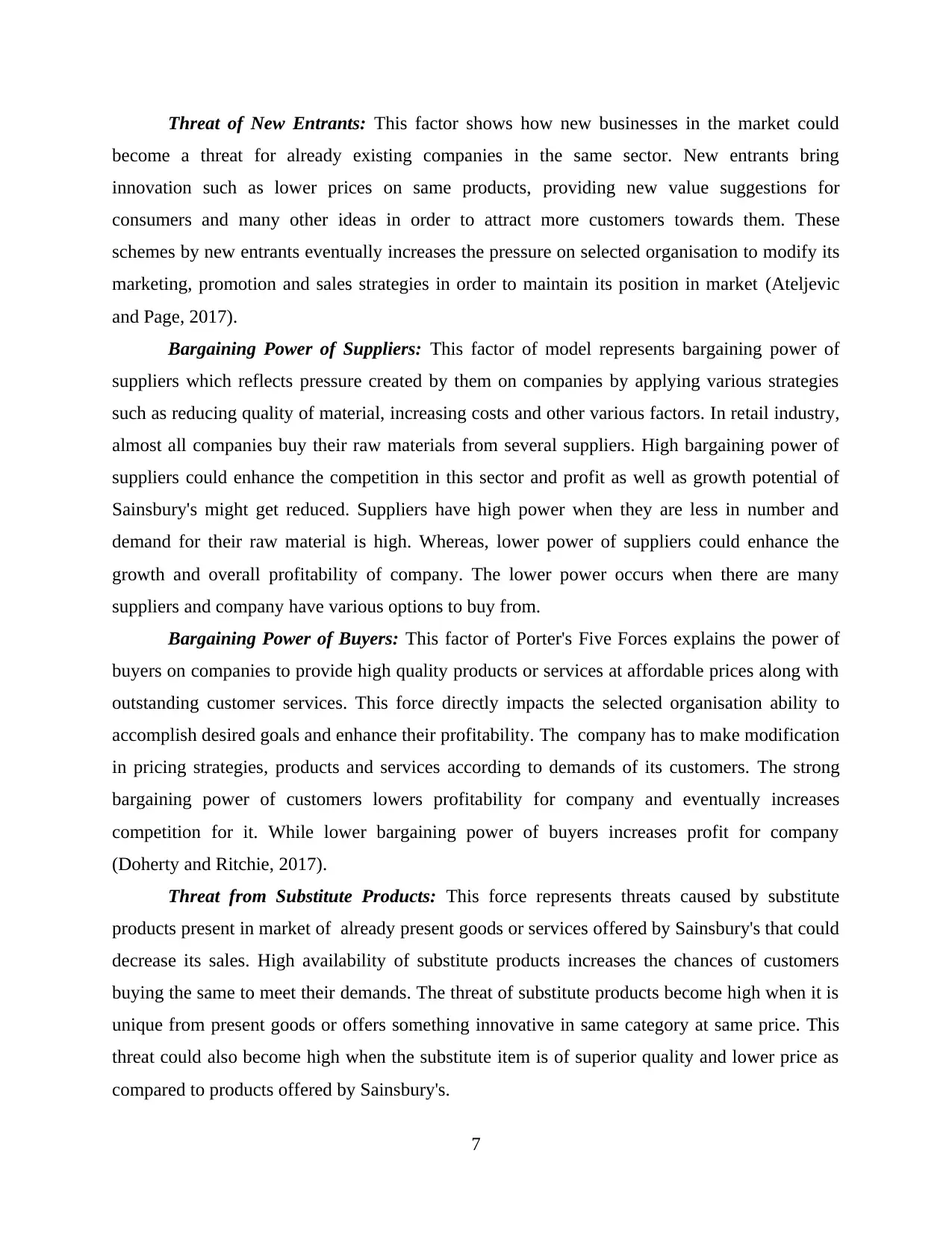
Threat of New Entrants: This factor shows how new businesses in the market could
become a threat for already existing companies in the same sector. New entrants bring
innovation such as lower prices on same products, providing new value suggestions for
consumers and many other ideas in order to attract more customers towards them. These
schemes by new entrants eventually increases the pressure on selected organisation to modify its
marketing, promotion and sales strategies in order to maintain its position in market (Ateljevic
and Page, 2017).
Bargaining Power of Suppliers: This factor of model represents bargaining power of
suppliers which reflects pressure created by them on companies by applying various strategies
such as reducing quality of material, increasing costs and other various factors. In retail industry,
almost all companies buy their raw materials from several suppliers. High bargaining power of
suppliers could enhance the competition in this sector and profit as well as growth potential of
Sainsbury's might get reduced. Suppliers have high power when they are less in number and
demand for their raw material is high. Whereas, lower power of suppliers could enhance the
growth and overall profitability of company. The lower power occurs when there are many
suppliers and company have various options to buy from.
Bargaining Power of Buyers: This factor of Porter's Five Forces explains the power of
buyers on companies to provide high quality products or services at affordable prices along with
outstanding customer services. This force directly impacts the selected organisation ability to
accomplish desired goals and enhance their profitability. The company has to make modification
in pricing strategies, products and services according to demands of its customers. The strong
bargaining power of customers lowers profitability for company and eventually increases
competition for it. While lower bargaining power of buyers increases profit for company
(Doherty and Ritchie, 2017).
Threat from Substitute Products: This force represents threats caused by substitute
products present in market of already present goods or services offered by Sainsbury's that could
decrease its sales. High availability of substitute products increases the chances of customers
buying the same to meet their demands. The threat of substitute products become high when it is
unique from present goods or offers something innovative in same category at same price. This
threat could also become high when the substitute item is of superior quality and lower price as
compared to products offered by Sainsbury's.
7
become a threat for already existing companies in the same sector. New entrants bring
innovation such as lower prices on same products, providing new value suggestions for
consumers and many other ideas in order to attract more customers towards them. These
schemes by new entrants eventually increases the pressure on selected organisation to modify its
marketing, promotion and sales strategies in order to maintain its position in market (Ateljevic
and Page, 2017).
Bargaining Power of Suppliers: This factor of model represents bargaining power of
suppliers which reflects pressure created by them on companies by applying various strategies
such as reducing quality of material, increasing costs and other various factors. In retail industry,
almost all companies buy their raw materials from several suppliers. High bargaining power of
suppliers could enhance the competition in this sector and profit as well as growth potential of
Sainsbury's might get reduced. Suppliers have high power when they are less in number and
demand for their raw material is high. Whereas, lower power of suppliers could enhance the
growth and overall profitability of company. The lower power occurs when there are many
suppliers and company have various options to buy from.
Bargaining Power of Buyers: This factor of Porter's Five Forces explains the power of
buyers on companies to provide high quality products or services at affordable prices along with
outstanding customer services. This force directly impacts the selected organisation ability to
accomplish desired goals and enhance their profitability. The company has to make modification
in pricing strategies, products and services according to demands of its customers. The strong
bargaining power of customers lowers profitability for company and eventually increases
competition for it. While lower bargaining power of buyers increases profit for company
(Doherty and Ritchie, 2017).
Threat from Substitute Products: This force represents threats caused by substitute
products present in market of already present goods or services offered by Sainsbury's that could
decrease its sales. High availability of substitute products increases the chances of customers
buying the same to meet their demands. The threat of substitute products become high when it is
unique from present goods or offers something innovative in same category at same price. This
threat could also become high when the substitute item is of superior quality and lower price as
compared to products offered by Sainsbury's.
7
⊘ This is a preview!⊘
Do you want full access?
Subscribe today to unlock all pages.

Trusted by 1+ million students worldwide
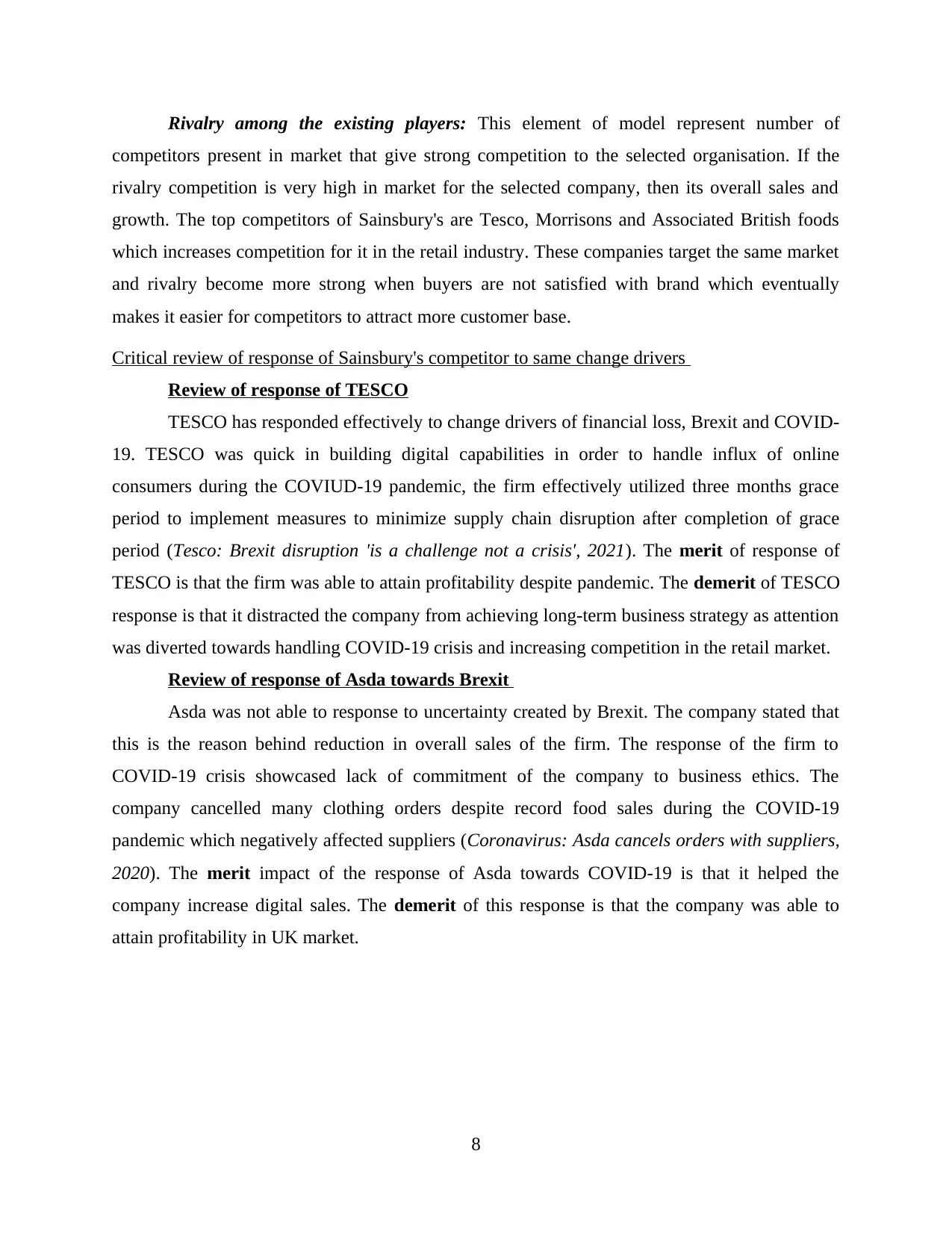
Rivalry among the existing players: This element of model represent number of
competitors present in market that give strong competition to the selected organisation. If the
rivalry competition is very high in market for the selected company, then its overall sales and
growth. The top competitors of Sainsbury's are Tesco, Morrisons and Associated British foods
which increases competition for it in the retail industry. These companies target the same market
and rivalry become more strong when buyers are not satisfied with brand which eventually
makes it easier for competitors to attract more customer base.
Critical review of response of Sainsbury's competitor to same change drivers
Review of response of TESCO
TESCO has responded effectively to change drivers of financial loss, Brexit and COVID-
19. TESCO was quick in building digital capabilities in order to handle influx of online
consumers during the COVIUD-19 pandemic, the firm effectively utilized three months grace
period to implement measures to minimize supply chain disruption after completion of grace
period (Tesco: Brexit disruption 'is a challenge not a crisis', 2021). The merit of response of
TESCO is that the firm was able to attain profitability despite pandemic. The demerit of TESCO
response is that it distracted the company from achieving long-term business strategy as attention
was diverted towards handling COVID-19 crisis and increasing competition in the retail market.
Review of response of Asda towards Brexit
Asda was not able to response to uncertainty created by Brexit. The company stated that
this is the reason behind reduction in overall sales of the firm. The response of the firm to
COVID-19 crisis showcased lack of commitment of the company to business ethics. The
company cancelled many clothing orders despite record food sales during the COVID-19
pandemic which negatively affected suppliers (Coronavirus: Asda cancels orders with suppliers,
2020). The merit impact of the response of Asda towards COVID-19 is that it helped the
company increase digital sales. The demerit of this response is that the company was able to
attain profitability in UK market.
8
competitors present in market that give strong competition to the selected organisation. If the
rivalry competition is very high in market for the selected company, then its overall sales and
growth. The top competitors of Sainsbury's are Tesco, Morrisons and Associated British foods
which increases competition for it in the retail industry. These companies target the same market
and rivalry become more strong when buyers are not satisfied with brand which eventually
makes it easier for competitors to attract more customer base.
Critical review of response of Sainsbury's competitor to same change drivers
Review of response of TESCO
TESCO has responded effectively to change drivers of financial loss, Brexit and COVID-
19. TESCO was quick in building digital capabilities in order to handle influx of online
consumers during the COVIUD-19 pandemic, the firm effectively utilized three months grace
period to implement measures to minimize supply chain disruption after completion of grace
period (Tesco: Brexit disruption 'is a challenge not a crisis', 2021). The merit of response of
TESCO is that the firm was able to attain profitability despite pandemic. The demerit of TESCO
response is that it distracted the company from achieving long-term business strategy as attention
was diverted towards handling COVID-19 crisis and increasing competition in the retail market.
Review of response of Asda towards Brexit
Asda was not able to response to uncertainty created by Brexit. The company stated that
this is the reason behind reduction in overall sales of the firm. The response of the firm to
COVID-19 crisis showcased lack of commitment of the company to business ethics. The
company cancelled many clothing orders despite record food sales during the COVID-19
pandemic which negatively affected suppliers (Coronavirus: Asda cancels orders with suppliers,
2020). The merit impact of the response of Asda towards COVID-19 is that it helped the
company increase digital sales. The demerit of this response is that the company was able to
attain profitability in UK market.
8
Paraphrase This Document
Need a fresh take? Get an instant paraphrase of this document with our AI Paraphraser
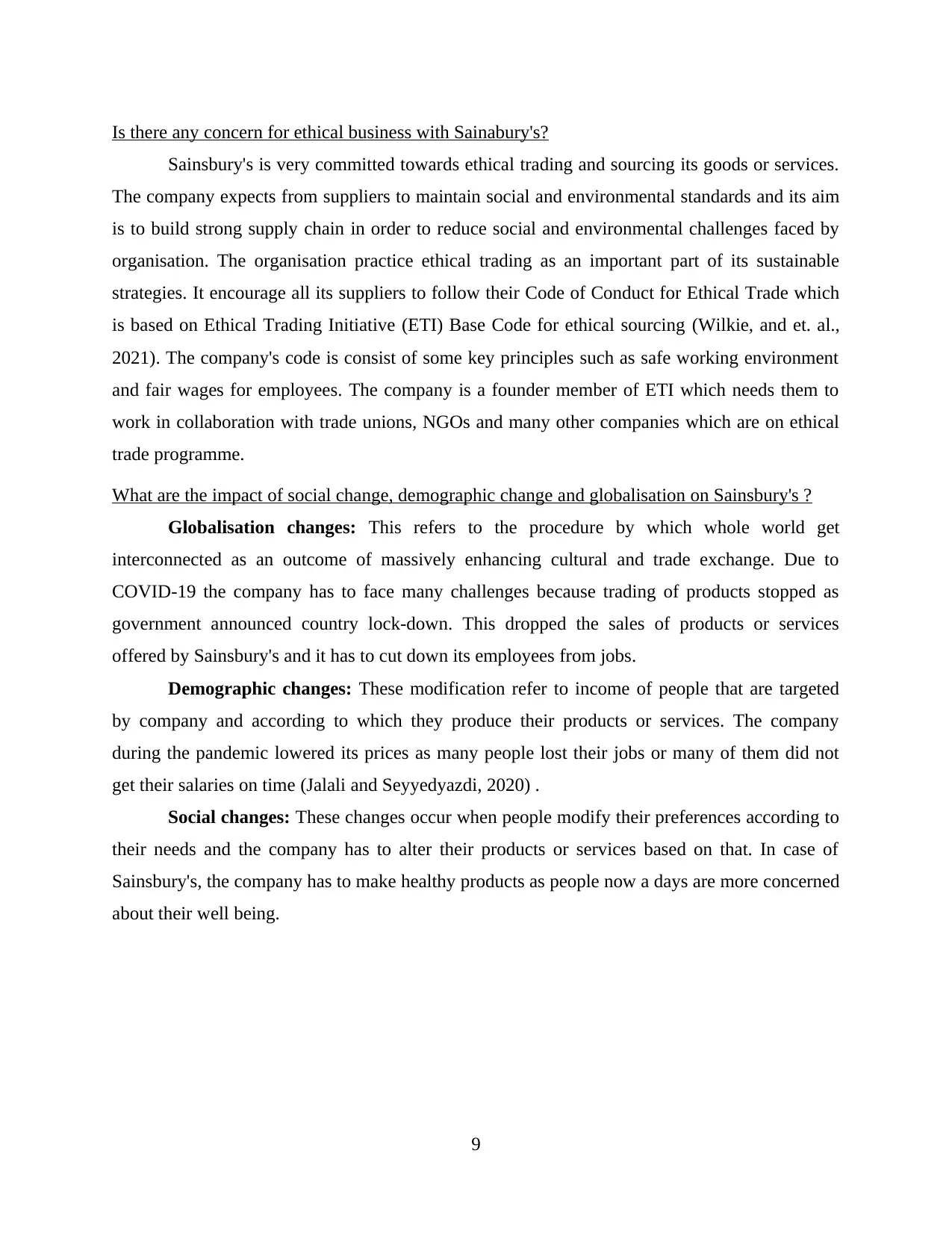
Is there any concern for ethical business with Sainabury's?
Sainsbury's is very committed towards ethical trading and sourcing its goods or services.
The company expects from suppliers to maintain social and environmental standards and its aim
is to build strong supply chain in order to reduce social and environmental challenges faced by
organisation. The organisation practice ethical trading as an important part of its sustainable
strategies. It encourage all its suppliers to follow their Code of Conduct for Ethical Trade which
is based on Ethical Trading Initiative (ETI) Base Code for ethical sourcing (Wilkie, and et. al.,
2021). The company's code is consist of some key principles such as safe working environment
and fair wages for employees. The company is a founder member of ETI which needs them to
work in collaboration with trade unions, NGOs and many other companies which are on ethical
trade programme.
What are the impact of social change, demographic change and globalisation on Sainsbury's ?
Globalisation changes: This refers to the procedure by which whole world get
interconnected as an outcome of massively enhancing cultural and trade exchange. Due to
COVID-19 the company has to face many challenges because trading of products stopped as
government announced country lock-down. This dropped the sales of products or services
offered by Sainsbury's and it has to cut down its employees from jobs.
Demographic changes: These modification refer to income of people that are targeted
by company and according to which they produce their products or services. The company
during the pandemic lowered its prices as many people lost their jobs or many of them did not
get their salaries on time (Jalali and Seyyedyazdi, 2020) .
Social changes: These changes occur when people modify their preferences according to
their needs and the company has to alter their products or services based on that. In case of
Sainsbury's, the company has to make healthy products as people now a days are more concerned
about their well being.
9
Sainsbury's is very committed towards ethical trading and sourcing its goods or services.
The company expects from suppliers to maintain social and environmental standards and its aim
is to build strong supply chain in order to reduce social and environmental challenges faced by
organisation. The organisation practice ethical trading as an important part of its sustainable
strategies. It encourage all its suppliers to follow their Code of Conduct for Ethical Trade which
is based on Ethical Trading Initiative (ETI) Base Code for ethical sourcing (Wilkie, and et. al.,
2021). The company's code is consist of some key principles such as safe working environment
and fair wages for employees. The company is a founder member of ETI which needs them to
work in collaboration with trade unions, NGOs and many other companies which are on ethical
trade programme.
What are the impact of social change, demographic change and globalisation on Sainsbury's ?
Globalisation changes: This refers to the procedure by which whole world get
interconnected as an outcome of massively enhancing cultural and trade exchange. Due to
COVID-19 the company has to face many challenges because trading of products stopped as
government announced country lock-down. This dropped the sales of products or services
offered by Sainsbury's and it has to cut down its employees from jobs.
Demographic changes: These modification refer to income of people that are targeted
by company and according to which they produce their products or services. The company
during the pandemic lowered its prices as many people lost their jobs or many of them did not
get their salaries on time (Jalali and Seyyedyazdi, 2020) .
Social changes: These changes occur when people modify their preferences according to
their needs and the company has to alter their products or services based on that. In case of
Sainsbury's, the company has to make healthy products as people now a days are more concerned
about their well being.
9
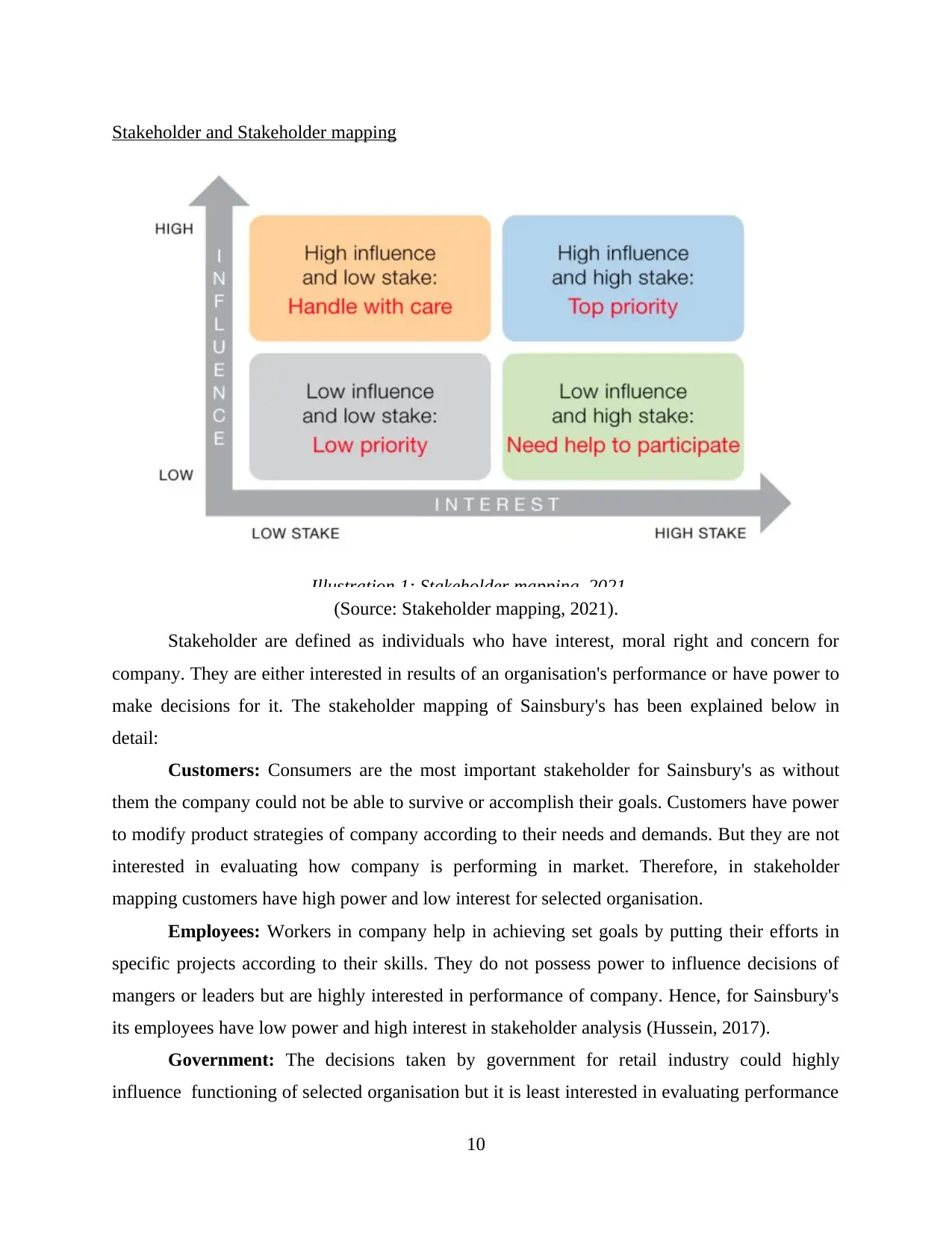
Stakeholder and Stakeholder mapping
(Source: Stakeholder mapping, 2021).
Stakeholder are defined as individuals who have interest, moral right and concern for
company. They are either interested in results of an organisation's performance or have power to
make decisions for it. The stakeholder mapping of Sainsbury's has been explained below in
detail:
Customers: Consumers are the most important stakeholder for Sainsbury's as without
them the company could not be able to survive or accomplish their goals. Customers have power
to modify product strategies of company according to their needs and demands. But they are not
interested in evaluating how company is performing in market. Therefore, in stakeholder
mapping customers have high power and low interest for selected organisation.
Employees: Workers in company help in achieving set goals by putting their efforts in
specific projects according to their skills. They do not possess power to influence decisions of
mangers or leaders but are highly interested in performance of company. Hence, for Sainsbury's
its employees have low power and high interest in stakeholder analysis (Hussein, 2017).
Government: The decisions taken by government for retail industry could highly
influence functioning of selected organisation but it is least interested in evaluating performance
10
Illustration 1: Stakeholder mapping. 2021.
(Source: Stakeholder mapping, 2021).
Stakeholder are defined as individuals who have interest, moral right and concern for
company. They are either interested in results of an organisation's performance or have power to
make decisions for it. The stakeholder mapping of Sainsbury's has been explained below in
detail:
Customers: Consumers are the most important stakeholder for Sainsbury's as without
them the company could not be able to survive or accomplish their goals. Customers have power
to modify product strategies of company according to their needs and demands. But they are not
interested in evaluating how company is performing in market. Therefore, in stakeholder
mapping customers have high power and low interest for selected organisation.
Employees: Workers in company help in achieving set goals by putting their efforts in
specific projects according to their skills. They do not possess power to influence decisions of
mangers or leaders but are highly interested in performance of company. Hence, for Sainsbury's
its employees have low power and high interest in stakeholder analysis (Hussein, 2017).
Government: The decisions taken by government for retail industry could highly
influence functioning of selected organisation but it is least interested in evaluating performance
10
Illustration 1: Stakeholder mapping. 2021.
⊘ This is a preview!⊘
Do you want full access?
Subscribe today to unlock all pages.

Trusted by 1+ million students worldwide
1 out of 17
Related Documents
Your All-in-One AI-Powered Toolkit for Academic Success.
+13062052269
info@desklib.com
Available 24*7 on WhatsApp / Email
![[object Object]](/_next/static/media/star-bottom.7253800d.svg)
Unlock your academic potential
Copyright © 2020–2025 A2Z Services. All Rights Reserved. Developed and managed by ZUCOL.




